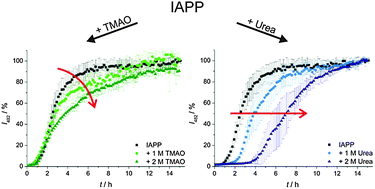Cosolvent effects on the fibrillation reaction of human IAPP
Abstract
Owing to the presence of various types of

- This article is part of the themed collection: Biophysical studies on protein misfolding and amyloid diseases
* Corresponding authors
a
Physical Chemistry I – Biophysical Chemistry, Faculty of Chemistry, TU Dortmund University, Otto-Hahn-Str. 6, 44227 Dortmund, Germany
E-mail:
roland.winter@tu-dortmund.de
Fax: +49-231-755-3901
Tel: +49-231-755-3900
Owing to the presence of various types of

 Please wait while we load your content...
Something went wrong. Try again?
Please wait while we load your content...
Something went wrong. Try again?
J. Seeliger, K. Estel, N. Erwin and R. Winter, Phys. Chem. Chem. Phys., 2013, 15, 8902 DOI: 10.1039/C3CP44412K
To request permission to reproduce material from this article, please go to the Copyright Clearance Center request page.
If you are an author contributing to an RSC publication, you do not need to request permission provided correct acknowledgement is given.
If you are the author of this article, you do not need to request permission to reproduce figures and diagrams provided correct acknowledgement is given. If you want to reproduce the whole article in a third-party publication (excluding your thesis/dissertation for which permission is not required) please go to the Copyright Clearance Center request page.
Read more about how to correctly acknowledge RSC content.
 Fetching data from CrossRef.
Fetching data from CrossRef.
This may take some time to load.
Loading related content
